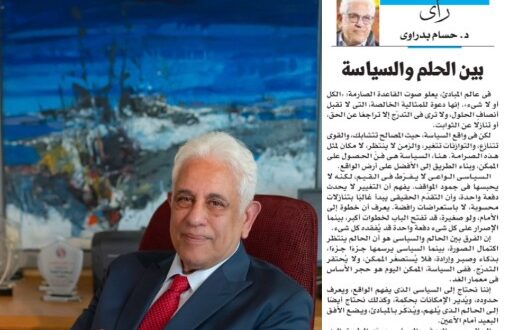Between Dream and Politics
By Hossam Badrawi
In the realm of principles, the rigid rule prevails: “All or nothing.” It is a call for pure idealism that refuses half-measures and sees gradual progress as a retreat from what is right or a compromise on core values.
However, in the world of politics, where interests intertwine, powers clash, balances shift, and time does not wait, there is no place for such rigidity. Here, politics is the art of achieving what is possible and building a path toward the best achievable reality.
A wise politician does not abandon values but also does not trap them in inflexible stances. They understand that change rarely occurs overnight and that real progress often starts with calculated compromises rather than stubborn refusals. They know that a step forward — even a small one — may open the door to greater steps, while insisting on achieving everything at once may result in losing everything.
The difference between a dreamer and a politician is that the dreamer waits for the picture to be complete, while the politician paints it piece by piece, with intelligence, patience, and determination.
The achievable should not be underestimated, nor should gradual progress be dismissed. In politics, what is possible today is the cornerstone of tomorrow’s structure.
We need a politician who understands reality, knows its limits, and manages resources wisely. But we also need the dreamer who inspires, reminds us of principles, and keeps the distant horizon in sight.
The dreamer outlines the goal, while the politician paves the way to it. The first lights the torch, and the second carries it without letting the wind extinguish it.
Regarding the Palestinian issue and the conflict with Zionism, there were periods when opportunities were lost because we demanded “everything now” and rejected anything less than the perceived ideal outcome.
Building the future cannot be achieved by excluding dreamers or discouraging politicians but rather through an alliance of reason and vision, gradual steps and ambition, action and purpose. The achievable is the seed of the dream, and the dream is what gives meaning to what is achievable.
Successful politics is not about surrendering to reality but mastering the art of using it to bring change.
I recalled several missed opportunities for the Palestinian people over the past five decades:
- After President Sadat’s visit to Israel and his powerful speech in the Knesset, Egypt invited all parties to the Mena House Conference, yet the Palestinian delegation did not attend.
- The Camp David Accords signed in 1978 addressed the Palestinian issue in a document titled “Framework for Peace in the Middle East.” This proposed granting Palestinians in the West Bank and Gaza temporary self-governance for five years while negotiating the final status. The framework included establishing an elected Palestinian authority to manage local affairs, Israeli withdrawal from specified areas, and initiating negotiations involving Israel, Egypt, Jordan, and Palestinian representatives to determine the final status of the territories. Arabs rejected this, believing it did not meet aspirations for full independence.
- The Oslo Accords, formally known as “Declaration of Principles on Interim Self-Government Arrangements,” was a peace agreement signed on September 13, 1993, between the PLO and Israel, overseen by U.S. President Bill Clinton. It resulted from secret talks in Oslo, Norway, aiming to outline steps toward resolving the Israeli-Palestinian conflict. Key points included mutual recognition between Israel and the PLO, the establishment of a Palestinian Authority to manage civil affairs in Gaza and the West Bank, and conducting elections for a Palestinian legislative council. The agreement also outlined a five-year transitional period with negotiations on core issues like Jerusalem, refugees, settlements, security, and borders. The agreement, however, was never fully implemented.
- The Clinton Parameters proposed in December 2000 by U.S. President Bill Clinton aimed to resolve the conflict. The plan included:
- A Palestinian state on 94-96% of the West Bank and all of Gaza, with Israel retaining major settlement blocs containing about 80% of settlers, and compensating Palestinians with land from inside Israel’s pre-1967 borders.
- Dividing Jerusalem based on demographic patterns: Arab neighborhoods under Palestinian sovereignty and Jewish neighborhoods under Israeli control, with Palestinian sovereignty over the Haram al-Sharif (Temple Mount) and symbolic Israeli ownership with guaranteed access for all faiths.
- An Israeli withdrawal from Palestinian areas within 36 months, followed by international monitoring.
- A demilitarized Palestinian state with a strong security force to maintain internal order.
Despite Israel’s partial acceptance, Palestinian leader Yasser Arafat raised significant concerns about dividing Jerusalem, ultimately rejecting the proposal.
As time passed, Arab negotiating power weakened, Palestinian leadership divisions increased, and proposals on the table gradually reduced Palestinian rights. The Golan Heights vanished from Arab demands, and the idea of a two-state solution grew increasingly distant. We even witnessed the audacity of calls for the forced displacement of over two million Palestinians to Jordan and Egypt.
I find no pride in what Hamas did on October 7, seeing 2.3 million Palestinians displaced, Gaza devastated, and 50,000 people killed. While some celebrate an illusionary victory, I have begun to believe that October 7 was one of the greatest victories for the Zionist state in its modern history.
I am beginning to think that a significant part of the Palestinian tragedy was the result of its leadership and the Arabs, as much as it was due to Israeli aggression.
Ambassador Mohamed Anis once reminded me of earlier events:
- The Peel Commission Report:
https://ar.wikipedia.org/wiki/ - The UN Partition Plan:
https://ar.wikipedia.org/wiki/ - Jordanian Administration of the West Bank:
https://ar.wikipedia.org/wiki/
 Dr. Hossam Badrawi Official Website
Dr. Hossam Badrawi Official Website


